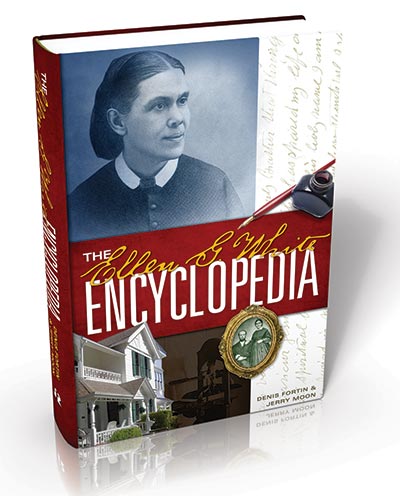
Denis Fortin and Jerry Moon, eds., The Ellen G. White Encyclopedia (Hagerstown, Md.: Review and Herald Publishing Association, 2013), 1,465 pages, $69.99 (hardcover) $19.99 (e-book), reviewed by Gerald A. Klingbeil, associate editor of Adventist Review.
There are key moments in Adventist publishing. The Ellen G. White Encyclopedia (2013) surely belongs in this category—along with the Seventh-day Adventist Bible Commentary (1953-1957), The Seventh-day Adventist Encyclopedia (1966, 1996), and, more recently, the Handbook of Seventh-day Adventist Theology (2000).
In the works for more than a decade, it represents a veritable tour de force on events, people, places, and topics connected with the life and ministry of Ellen G. White, one of the cofounders of the Seventh-day Adventist Church. The volume is divided into three main sections.
Section one contains articles that provide in-depth discussion of Ellen White’s life, her chronology, her writings, archival resources for those who want to dig deep into her writings, a complete bibliography, as well as a review of her theological focus and a helpful introduction to a valid hermeneutics of her writings. The application of these hermeneutical principles is then applied to 12 controversial statements by Ellen White (such as, lethal wigs, toxic cosmetics, leprosy from eating pork, problems involving the great difference in the age of marriage partners, the causes of earthquakes and volcanic eruptions). As most teachers know, an image is often more instructive than a thousand words. True to that principle, the book includes a number of available photos of Ellen White—often in the company of other church leaders or family members—and several maps that help readers trace her movement and ministry geographically.
Section two focuses on people and their connection to Ellen White. The biographical section (pp. 287-573) is full of up-to-date background information on contemporaries of Ellen White (including colaborers, family members, or people who had a marked influence on her life). The entries are generally written by specialists who have spent significant time researching a particular person (e.g., George Knight wrote on Joseph Bates; Daniel Heinz from Theologische Hochschule Friedensau wrote on Ludwig Conradi; Bill Knott wrote on Hannah More). Most biographical entries contain bibliographical references for further reading; others include a photo of the person, if available; they all help readers get a feel for the real Ellen White and her relationships in a movement whose origins and growth are awe-inspiring. Not all entries have been signed, which indicates that the entry was written by one of the editors. In fact, the preface tells us that most of the unsigned biographical entries were written by assistant editor Michael Campbell (pp. 13, 14).
Section three, by far the longest, covering 720 pages, focuses on different topics, including theological themes of Ellen White’s writings, historical events and places, and institutions she was connected with. Unfortunately, I could not find a rationale explaining to readers the selection of topics for this section. Similar to section two, most entries include suggestions for further reading and are signed.
The length of the entries varies significantly. For example, the entry “Revelation and Inspiration”—undoubtedly significant in terms of hermeneutics and Ellen White’s own approach to Scripture—covers nearly six two-column pages. Other critical entries (such as “General Conference Session of 1888” or “Christ, Divinity of” and “Christ, Humanity of”) are of similar length. Some entries reflect contemporary issues (and interest), such as the lengthy “Creation and Evolution.” In other cases I would have wished for a more comprehensive look at topics that Ellen White did not mention specifically, but where her writings include valuable principles pertaining to that topic. A “Media/Media Use” entry would have been more relevant than the helpful (albeit limited) “Drama and Theater” discussion.
The well-edited volume concludes with four appendices (including Ellen White’s genealogy chart, a chart illustrating the relationship between early books, a list of her letters, and a list of her manuscripts).
Kudos to the intrepid editors who spent more than a decade writing, editing, and—I imagine—most of the time interacting with tardy authors requiring additional time. Anybody interested in Adventist history should have a copy of this book—either in printed form or as an e-book on a tablet (which actually facilitates digital searches).